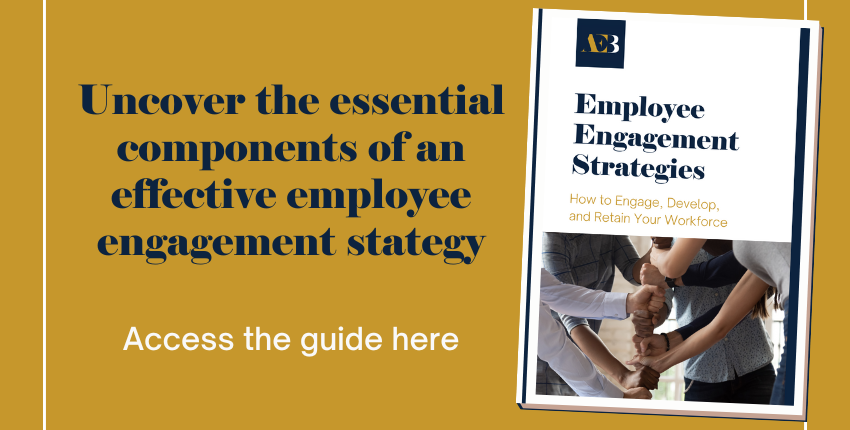In recent years, career development and the expectations of employees have evolved. Static career paths are no longer relevant, especially as more and more employees job-hop for better opportunities than ever before.
Employees are much more focused on professional development and growth than ever before. If their current employer is not fulfilling an individual's desire for continued education and knowledge, many employees will leave for new, more promising opportunities. This makes the job market more competitive than ever, meaning that it's not just enough to offer a good benefits package. There’s one obvious answer that few organizations fully utilize: employee development.
Keep reading to gain a better understanding of employee development and specifically why investing in your employees matters and what an effective plan should include.
What Does Employee Development Look Like?
What employee development is and isn’t
Employee development is a common phrase within human resources and professional settings, but what exactly is it? Employee development is a collaborative effort between the employee and employer enhance the individual's skills, competencies, and knowledge within their specific industry. This may involve instructing the team on the utilization of new technologies or strategic approaches, offering training programs that foster internal leadership development, and implementing skill-focused training modules to enhance overall employee performance. Given the dynamic nature of many industries, professional growth initiatives are crucial for keeping employees abreast of evolving trends, enabling them to consistently deliver their best performance every day.
Employee development can take on many different forms and range from the very formal and required to the extremely casual and self-directed. What employee development looks like at your company may in part already be determined for you by your industry.
As an example, the insurance industry is highly regulated and therefore requires licenses based on your specific role (agent, adjuster, broker), the state you are working, the types of insurance policies sold, and in some cases based on the specific insurance provider. Since these licenses need to be regularly renewed, specific ongoing education and training are critical.
Conversely, employee development can also be very casual and up to the discretion of the employee or employer based on areas of interest or professional goals. This may require employers to get creative in what employee development looks like for employees, especially if opportunities can be tailored to the role or industry.
Here are some ideas:
- Build a library of industry and role-specific books and videos
- Register employees for online or in-person seminars or classes
- Suggest self-paced learning courses based on platforms or products your business regularly uses
- Create a mentorship program for senior-level employees to develop and guide junior-level or new employees
- Develop job shadowing or specific project opportunities so employees can see first-hand career options in different departments
- Start a lunch & learn series to help your entire team improve on required skill sets or to learn about a new initiative or program
- Create unique development plans tailored to each employee based on their career path within your organization.
Yet regardless of how it’s structured, at its core employee development is ongoing learning and training supported or created by an employer to enable employees to improve their skills and knowledge for both their current role, as well as future opportunities within your organization.
This is different from professional development programs because of who is driving the initiative for ongoing learning. Professional or career development is focused on an individual’s larger career goals with the understanding that new skills and knowledge gained could take them outside the organization. As such, professional development is usually initiated by the individual.
Why Investing in Your Employees Matters
Your business growth is often dependent on the employees you have on board. When your team is excited about your business and motivated, you will find success. Highly engaged employees have improved job performance which has an impact on customer satisfaction, innovation, and more. When your employees are not engaged and lack enthusiasm for your company, your business growth might stall. Your team might struggle to retain high-quality employees because they’re constantly looking for new, more engaging opportunities. How do you combat this cyclical issue? Investing in your employees.
Companies often invest in what they want to keep, meaning they nurture and develop what matters most to them. This goes for the employees they want to keep around. There are several critical reasons why investing in your employees’ development is highly beneficial to your company and resolves growth-inhibiting factors. Employee development can address all of these by:
-
Supporting driven individuals with a passion to succeed by defining a clear path of career progression. Employees want to know their careers are going someplace and how they are going to get there. They can either advance with your company or simply use you as a stepping stone.
-
Acting as an effective management tool to help great employees excel in their field or find new passions while serving as a method of correction and redirection for underperforming employees.
- Increasing employee engagement and productivity. Engaged employees are typically more productive. And while employee engagement can be increased through various strategies, an employee development plan can play a huge role in employees because more involved and hands-on regarding organizational growth.
-
Encouraging organizational growth by training and preparing your team for what lies ahead. Standing still in business today means being steps behind tomorrow.
-
Adding job value for the employee. Advanced knowledge and skills can lead to promotions and higher income. When employees are invested in, they feel valued and respected.
-
Providing organizational value for the employer. Investing in your employees shows you value them, valued employees are more engaged in their professional roles, and engaged employees provide higher levels of productivity and profitability.
-
Making an organization more attractive and competitive. Businesses with high levels of engagement also have positive company cultures. This increases employee retention, meaning you have talented individuals working for you, which in turn attracts elite candidates giving you a competitive edge.
- Improves employee retention. Employee development gives your employees a reason to not only remain engaged with your company but investing your organization as well. Employees are more likely to stay with organizations that nurture their careers and provide opportunities for individual growth.
-
Allowing companies to plan for succession. What would happen to your company if your owner left, sold the business, or retired? Developing your employees from day one allows for a successful transition between leadership and for a legacy to continue.
Employee development is a key factor in fostering a positive workplace culture. And if you want to retain your employees and have a motivated, engaged team you need to ensure they are continually learning, adapting, and growing in their respective roles. On the flip side of this, poor performance can result from a lack of knowledge, a lack of training, a lack of interest, and/or a lack of engagement.
What an Effective Employee Development Plan Should Include
Whether your employee development opportunities are formal or informal, you do need to create structure around whatever you provide and create for your employees. Just like there is proven value with a structured hiring process and structured interview methods, your organization will gain the most value from designing a clear framework around your employee development plans.
- Position employee development as a subset of your performance management plans. Think about the larger strategic goals you have for your business. The performance of each member of your team and the tasks each role is responsible for support those goals. Employee development allows you to train your employees for what is next or to improve upon what may be lacking. Where is your organization headed and what do your employees need to know to get there?
- Review the responsibilities for each role and employee. What is each employee expected to accomplish and what are they held accountable for? Just like you would define these when creating a job posting, this step is also valuable in determining where there may be gaps in critical knowledge or opportunities to strengthen the role. Further, it allows you to personalize employee development plans for each individual and their career path. Just make sure you have a method to document and track the career growth of your employees.
- During your onboarding process, make sure your new employees fully understand what is expected of them in all aspects of their roles. Charting their career path and highlighting where opportunities for employee development exist, will help cement their decision to join your organization.
- Determine what metrics or key performance indicators (KPIs) will be used to quantify the output of each role. The goal is to measure and track outcomes to establish a baseline and growth pattern for performance. This information will help you both identify areas to improve or where to gain new skills and knowledge.
Your employees may be the biggest investment made in your organization and employee development is just one way to ensure you’re building a strong business team. Make sure you manage that investment well by creating an effective program in a way that fits the needs of your business and employees. It matters for the longevity and success of your organization and your growing team.


.png)






